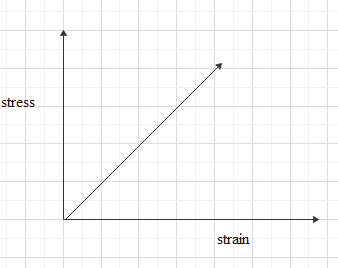
According to Hooke's law of elasticity, if stress is increased, the ratio of stress to strain.
A. becomes zero.
B. remains constant.
C. decreases.
D. increases.
Answer
508.5k+ views
Hint: Hooke's law which states that the extension produced in the wire is directly proportional to the load applied. Thomas Young modified the statement as within the elastic limit the stress is directly proportional to strain.
Complete answer:
According to Hooke's law of elasticity, if stress is increased, the ratio of stress to strain remains constant which is additionally referred to as Young’s modulus.
$\begin{align}
& \text{stress}\propto \text{strain} \\
& \text{stress=constant }\!\!\times\!\!\text{ strain} \\
& \dfrac{\text{stress}}{\text{strain}}\text{=constant} \\
\end{align}$
So, the correct answer is “Option B”.
Additional Information:
Stress: if a body gets deformed under the action of an external force, then at each section of the body an internal force of reaction is set up which tends to restore the body of the original state. The internal restoring force which is set up per unit area of the cross section when the body is deformed is called stress.
Stress are of the three types:
1. Tensile stress.
2. Compressional stress.
3. Hydrostatic stress.
4. Tangential or shearing stress.
Strain:
When a deforming force acts on any Body, the body undergoes a change in its shape and size and the ratio of the change in any dimension produced in the body to the original dimension of the body is strain.
Types of strain:
1. Longitudinal strain.
2. Volumetric strain.
3. Shear strain.
Note:
The constant of proportionality is called modulus of elasticity or coefficient of elasticity. Hooke’s Law is only in the linear portion of the stress strain curve. The law is not valid for large values of strain.

Modulus of elasticity: Modulus of elasticity or coefficient of elasticity of a body is defined as the ratio of stress to the corresponding strain within the elastic limit.
Stress is not a vector quantity because the stress cannot be assigned a specific direction unlike a force.
Complete answer:
According to Hooke's law of elasticity, if stress is increased, the ratio of stress to strain remains constant which is additionally referred to as Young’s modulus.
$\begin{align}
& \text{stress}\propto \text{strain} \\
& \text{stress=constant }\!\!\times\!\!\text{ strain} \\
& \dfrac{\text{stress}}{\text{strain}}\text{=constant} \\
\end{align}$
So, the correct answer is “Option B”.
Additional Information:
Stress: if a body gets deformed under the action of an external force, then at each section of the body an internal force of reaction is set up which tends to restore the body of the original state. The internal restoring force which is set up per unit area of the cross section when the body is deformed is called stress.
Stress are of the three types:
1. Tensile stress.
2. Compressional stress.
3. Hydrostatic stress.
4. Tangential or shearing stress.
Strain:
When a deforming force acts on any Body, the body undergoes a change in its shape and size and the ratio of the change in any dimension produced in the body to the original dimension of the body is strain.
Types of strain:
1. Longitudinal strain.
2. Volumetric strain.
3. Shear strain.
Note:
The constant of proportionality is called modulus of elasticity or coefficient of elasticity. Hooke’s Law is only in the linear portion of the stress strain curve. The law is not valid for large values of strain.

Modulus of elasticity: Modulus of elasticity or coefficient of elasticity of a body is defined as the ratio of stress to the corresponding strain within the elastic limit.
Stress is not a vector quantity because the stress cannot be assigned a specific direction unlike a force.
Recently Updated Pages
Master Class 11 Economics: Engaging Questions & Answers for Success

Master Class 11 English: Engaging Questions & Answers for Success

Master Class 11 Social Science: Engaging Questions & Answers for Success

Master Class 11 Biology: Engaging Questions & Answers for Success

Class 11 Question and Answer - Your Ultimate Solutions Guide

Master Class 11 Business Studies: Engaging Questions & Answers for Success

Trending doubts
10 examples of friction in our daily life

One Metric ton is equal to kg A 10000 B 1000 C 100 class 11 physics CBSE

Difference Between Prokaryotic Cells and Eukaryotic Cells

1 Quintal is equal to a 110 kg b 10 kg c 100kg d 1000 class 11 physics CBSE

Explain zero factorial class 11 maths CBSE

What is a periderm How does periderm formation take class 11 biology CBSE




